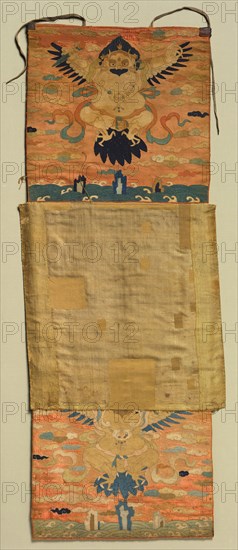
Sujet
Vajrapani Embroidered Mount with Garuda, painting 1600s, embroidery c. 1300. Creator: Chöying Dorjé, the Tenth Black Hat Karmapa (Tibetan, 1604-1674).
Légende
Vajrapani Embroidered Mount with Garuda, painting 1600s, embroidery c. 1300. Kneeling and holding his left hand in a gesture of reverential greeting, this Buddhist protector holds a stylized thunderbolt called a vajra, for which he is named. His black body is set off by the gold cloud and flames that stand out from the indigo sky through which birds of prey fly with serpents. His hair stands on end, and his eyes-including his third eye of wisdom-bulge with ferocity. These attributes, plus the powerful bulk of his body, convey his ability to eradicate obstacles to enlightenment. Though unsigned, the painting appears to have been made by a high-ranking Tibetan patriarch. Rare examples of textiles from the Yuan dynasty (1279-1368), the upper and lower borders feature the Indian man-eagle Garuda, who in Tibetan Buddhism is associated with Vajrapani. Garuda hovers over the three Islands of the Immortals that rise from the stylized waters of the Eastern Sea, a motif associated with the Chinese religion of Daoism. Cross-cultural visual references to Indian, Tibetan, and Chinese images come together in this remarkable devotional ensemble.
Crédit
Photo12/Heritage Images/Heritage Art
Notre référence
HRM19G21_004
Model release
NA
Property release
NA
Licence
Droits gérés
Format disponible
53,3Mo (9,1Mo) / 24,1cm x 55,5cm / 2844 x 6550 (300dpi)